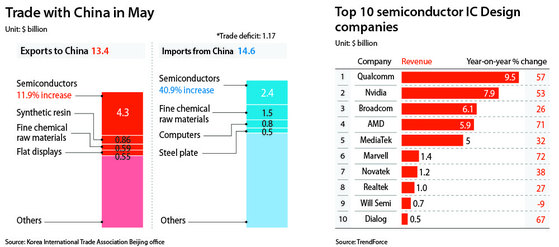China turns the table on Korea with low-end chips

U.S. high-tech restrictions on China are taking a toll on Korea's trade balance.
For the first time in 30 years, Korea has recorded a trade deficit with China, its biggest trading partner.
Exports to the country totaled $13.4 billion in May and imports $14.6 billion, resulting in a $1.1 billion deficit, according to the Korea Custom Service. This month, a $690 million shortfall is forecast.
The government is concerned about the growing trade deficit with China, and the Korea International Trade Association (KITA) Beijing office has started to work on damage assessment.
According to a KITA study, 16.5 percent of Korea's imports from China were semiconductors, 10.3 percent fine chemicals for batteries and 5.5 percent computers.
Last month, Korea imported $2.4 billion of Chinese semiconductors, a 40.9 percent increase year-on-year. Korea's No.1 export to China was semiconductors. On year, semiconductor exports to China were up 11 percent.
China has been speeding up its semiconductor localization after efforts by the United States to cut it off from certain key technologies.
The development of semiconductors in China is being pursued much as the country pursued the atomic bomb, the hydrogen bomb and the satellite.
Next-generation IT technology and semiconductors were picked as China's biggest priority when its government in 2015 announced its top 10 strategic industries for its 2025 manufacturing plan.
According to the China Semiconductor Industry Association, the Chinese government provided 138.7 billion yuan (26.7 trillion won), to the top 50 Chinese semiconductor manufacturers and design companies.
And under its five-year economic plan announced in 2020, the Chinese government created at 204.1 billion yuan (39.3 trillion won) semiconductor fund.
The Chinese government plans to provide 1 trillion yuan (190 trillion won) by 2025.
Backed by aggressive support from the Chinese government, Chinese semiconductor fabless technology has been developing rapidly.
Shanghai's Will Semiconductor was the No. 9 ranked semiconductor design company in the world in the first quarter, according to TrendForce. The company specializes in designing CMOS image sensor semiconductors, which go into a camera.
China has roughly 1,600 semiconductor design companies. They design application processors and other chips.
Chinese companies are considered to be focused on designing low-end semiconductors.
Samsung Electronics and Taiwan's TSMC are in an intense race to develop 3-nanometer semiconductors.
SMIC has only a single 14-nanometer semiconductor production plant in Shanghai. Most Chinese semiconductor companies are still manufacturing 28-nanometer or higher semiconductors.
This is largely because 7-nanometer lithography equipment developed by ASML, which is necessary for high performance, high quality semiconductors, is banned from being exported to China by the United States.
Due to the restrictions, China's SMIC started to focus on the production of semiconductors that don't require such high quality machinery.
This resulted in aggressive production. Last year China manufactured over 359 billion chips, a 33.3 percent increase.
According to Semiconductor Equipment and Material International, China in the last two years was the world's No. 1 buyer of semiconductor manufacturing equipment.
Last year China bought $29.6 billion worth, although some of the equipment purchased wasn't brand new.
"In China there are over 70,000 companies related to semiconductors," said Ko Young-hwa, a researcher at the Center for Korean Peninsula Studies at Peking University. "China is adopting a strategy of flooding the semiconductor market."
China is fast developing AI chips, which are used for voice and image recognition. It has been particularly strong in surveillance camera and heat sensing camera chips and has also focused on technologies that would reduce errors in object recognition, which is essential for the development of autonomous vehicles.
AI semiconductor efforts would allow China to develop a field not already dominated by existing manufacturers.
"China is significantly increasing its investment in sensors and AI semiconductors," said Lee Woo-keun, a micromechanics professor at Tsinghua University. "China has the potential to win big.
"We're at a point where we have to closely monitor China's semiconductor industry, which is pouring in a massive amount of funding and is focused on developing a high-quality workforce."
BY PARK SEONG-HUN [lee.hojeong@joongang.co.kr]










with the Korea JoongAng Daily
To write comments, please log in to one of the accounts.
Standards Board Policy (0/250자)